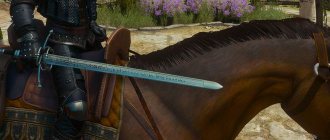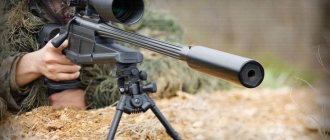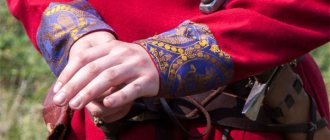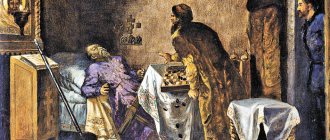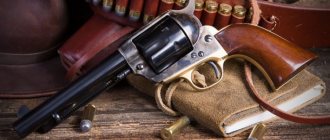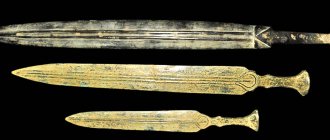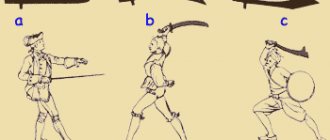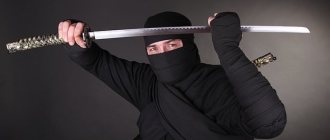TEST: Which Internet profession is right for you?
Take a free test and find out which specialty you can quickly master and become a sought-after, highly paid specialist
Take the test!
The sword has always been the weapon of the nobility. The knights treated their blades as comrades in battle, and, having lost his sword in battle, a warrior covered himself with indelible shame. Among the glorious representatives of this type of bladed weapon there is also its own “nobility” - famous blades, which, according to legend, have magical properties, for example, putting enemies to flight and protecting their owner. There is some truth in such stories - an artifact sword by its very appearance could inspire the companions of its owner. We present to you 12 of the most famous deadly relics in history.
Sword in the Stone
Many people remember the legend of King Arthur, which tells how he plunged his sword into a stone to prove his right to the throne. Despite the complete fantastic nature of this story, it may be based on real events that only occurred much later than the estimated reign of the legendary king of the Britons.
In the Italian chapel of Monte Siepi there is kept a block with a blade firmly embedded in it, which, according to some sources, belonged to the Tuscan knight Galliano Guidotti, who lived in the 12th century.
According to legend, Guidotti had a bad temper and led a rather dissolute lifestyle, so one day the Archangel Michael appeared to him and urged him to take the path of serving the Lord, that is, to become a monk. Laughing, the knight declared that going to the monastery would be as difficult for him as cutting a stone, and to confirm his words, he forcefully struck a boulder lying nearby with his blade. The Archangel showed the stubborn man a miracle - the blade easily entered the stone, and the amazed Galliano left it there, after which he embarked on the path of correction and was later canonized, and the fame of his sword, which pierced the stone, spread throughout Europe.
Having subjected the block and sword to radiocarbon analysis, an employee of the University of Pavia, Luigi Garlaschelli, discovered that some part of this story may well be true: the age of the stone and sword is about eight centuries, that is, it coincides with the life of Signor Guidotti.
Kusanagi no Tsurugi
This mythical sword has been a symbol of the power of Japanese emperors for several centuries. Kusanagi no Tsurugi (translated from Japanese as “sword that mows grass”) is also known as Ame-nomurakumo no Tsurugi - “sword that collects the clouds of heaven.”
The Japanese epic says that the sword was found by the wind god Susanoo in the body of an eight-headed dragon he killed. Susanoo gave the blade to his sister, the sun goddess Amaterasu, later it ended up with her grandson Ninigi, and after some time it went to the demigod Jimmu, who then became the first emperor of the Land of the Rising Sun.
It is interesting that the Japanese authorities never put the sword on public display, but, on the contrary, tried to hide it away from prying eyes - even during coronations the sword was carried out wrapped in linen. It is believed to be kept at the Atsuta Shinto shrine in Nagoya, but there is no evidence of its existence.
The only ruler of Japan to publicly mention the sword was Emperor Hirohito: giving up the throne after the country's defeat in World War II, he called on the temple servants to keep the sword at all costs.
Durendal
For centuries, parishioners of the Not-Dame chapel, located in the city of Rocamadour, could see a sword stuck in the wall, which, according to legend, belonged to Roland himself, a hero of medieval epics and legends who existed in reality.
According to legend, he threw his magic blade while protecting the chapel from the enemy, and the sword remained in the wall. Attracted by these tales of the monks, numerous pilgrims flocked to Rocamadour, who retold the story of Roland's sword to each other, and thus the legend spread throughout Europe.
Bloodthirsty Blades of Muramasa
Muramasa was a famous Japanese swordsman and blacksmith who lived in the 16th century. According to legend, Muramasa prayed to the gods to imbue his blades with bloodthirstiness and destructive power. The master made very good swords, and the gods respected his request, placing a demonic spirit of extermination of all living things in each blade.
It is believed that if the Muramasa sword gathers dust for a long time without use, it can provoke the owner to commit murder or suicide in order to “drink” blood in this way. There are countless stories of Muramasa sword wielders who went crazy or slaughtered many people. After a series of accidents and murders that occurred in the family of the famous shogun Tokugawa Ieyasu, which popular rumor associated with Muramasa's curse, the government outlawed the master's blades, and most of them were destroyed.
To be fair, it must be said that the Muramasa school is an entire dynasty of gunsmiths that lasted for about a century, so the story of the “demonic spirit of bloodthirstiness” embedded in swords is nothing more than a legend. The curse of the blades made by the masters of the school was, paradoxically as it may sound, their exceptional quality. Many experienced warriors preferred them to other swords and, apparently, thanks to their art and the sharpness of Muramasa’s blades, they won victories more often than others.
The best swords of witcher schools
The best swords of witcher schools are undoubtedly the Grandmaster swords. This weapon is of the highest quality, with a spectacular appearance and is extremely rare.
How to get the swords of the first five schools: get a drawing during the quest “Ancient Witchers: Grandmaster Armor of the Griffin/Cat/Bear/Wolf/Manticore School” and forge a sword from a grandmaster gunsmith or higher rank.
Griffin School
This witcher school traditionally specializes in the use of signs, which is why their weapons are designed for this. In close combat, griffins prefer precise and powerful strikes. They never drag out a battle with the enemy. The Blood and Wine DLC must be purchased. Requires level 40 to use.
| Steel | Silver |
| Damage 551-673 health units | Damage 742-906 health units |
| Power of signs +25% | Power of the sign +25% |
| Crit chance and chance to cut off limb +10% | Crit chance and chance to cut off limb +10% |
| Additional experience for a fatal blow to a person +5% | Additional experience for killing a monster +20% |
| Rune slots – 3 pcs. | Rune slots – 3 pcs. |
Kota School
A school of witcher art that prefers to rely on agility and speed in battle. Their movements are flexible and precise. They prefer to inflict many blows on the enemy, which subsequently cause severe damage. The Blood and Wine DLC must be purchased. Requires level 40 to use.
| Steel | Silver |
| Damage 551-673 health units | Damage 742-906 health units |
| Power of the Aard sign +20% | Power of the Aard sign +15% |
| Crit chance and chance to cut off limb +15% | Crit chance and chance to cut off limb +15% |
| Additional experience for a fatal blow to a person +5% | Additional experience for killing a monster +20% |
| Rune slots – 3 pcs. | Rune slots – 3 pcs. |
Wolf School
A school whose fighting style is based on the use of two two-handed blades - silver and steel at the same time. The Blood and Wine DLC must be purchased. Requires level 40 to use.
| Steel | Silver |
| Damage 551-673 health units | Damage 742-906 health units |
| Power of the Aard sign +20% | Power of signs +25% |
| Crit chance and chance to cut off limb +15% | Crit chance and chance to cut off limb +10% |
| Additional experience for a fatal blow to a person +5% | Additional experience for killing a monster +20% |
| Rune slots – 3 pcs. | Rune slots – 3 pcs. |
Bear School
In battles, bears rely on their strength. They prefer to accumulate adrenaline, which can be channeled into one deadly and powerful blow that can cut the enemy in two. The Blood and Wine DLC must be purchased. Requires level 40 to use.
| Steel | Silver |
| Damage 551-673 health units | Damage 742-906 health units |
| Gaining adrenaline +25% | Gaining adrenaline +25% |
| Crit chance and chance to cut off limb +5% | Crit chance and chance to cut off limb +5% |
| Additional experience for a fatal blow to a person +5% | Additional experience for killing a monster +5% |
| Rune slots – 3 pcs. | Rune slots – 3 pcs. |
Manticore School
Members of this witcher school often use elixirs because they have increased stamina and high intoxication. Bombs also often appear in their arsenal. When fencing, manticores love to deliver powerful and accurate blows. The Blood and Wine DLC must be purchased. Requires level 40 to use.
| Steel | Silver |
| Damage 335-409 health units | Damage 472-576 health units |
| Armor Penetration +250 | Armor Penetration +250 |
| Bonus damage on critical hit +50% | Bonus damage on critical hit +50% |
| Chance of bleeding +10% | Crit chance and Additional experience for a fatal blow to a monster +5% |
| Crit chance and Additional experience for a fatal blow to a person +5% | Chance of bleeding +10% |
Honjo Masamune
Unlike the bloodthirsty swords of Muramasa, the blades made by the master Masamune, according to legend, endowed warriors with calmness and wisdom. According to legend, in order to find out whose blades were better and sharper, Muramasa and Masamune dipped their swords into a river with lotuses. The flowers revealed the essence of each of the masters: the blade of Masamune’s sword did not inflict a single scratch on them, because his blades cannot harm the innocent, and Muramasa’s product, on the contrary, seemed to be striving to cut the flowers into small pieces, justifying its reputation.
Of course, this is pure fiction - Masamune lived almost two centuries earlier than the gunsmiths of the Muramasa school. However, Masamune swords are truly unique: the secret of their strength has not yet been revealed, even using the latest technologies and research methods.
All surviving blades of the master's work are national treasures of the Land of the Rising Sun and are carefully protected, but the best of them, Honjo Masamune, was given to American soldier Colde Bimor after the surrender of Japan in World War II, and its whereabouts are currently unknown. The government of the country is trying to find a unique blade, but so far, alas, in vain.
Tati - a sword equal in length to a Katana
Japanese long sword tachi 41 inches. The wavy hamon pattern on the blade is clearly visible.
The most ancient handmade katana (katana sheaths were also handmade and decorated with ornaments) are most valued and passed down from generation to generation as a family heirloom. Such katana are very expensive, especially if you can see Mei on it - a mark with the name of the master and the year of manufacture on the shank of a Japanese bladed weapon - of any famous master.
Many master gunsmiths from different countries tried to copy the katana, which resulted in such famous swords as: Three - a Tibetan sword copying a samurai sword; Taijinjian (Chinese sword of the great limit) is a type of jian; Korean sword, Japanese name katana in the 7th-13th centuries; etc. But real katana can only be found in Japan, and if a katana is not made in Japan, it is no longer a katana!
Joyeuse
Step-by-step plan for making money by setting up VKontakte advertising
Learn VKontakte advertising in 3 days and start earning money remotely from RUR 50,000. per month.
Sign up for training
The Joyeuse blade (translated from the French “joyeuse” - “joyful”), according to legend, belonged to the founder of the Holy Roman Empire, Charlemagne, and served him faithfully for many years. According to legend, he could change the color of the blade up to 30 times a day and outshine the Sun with its brightness. Currently, there are two blades that the famous monarch could wield.
Sword of Saint Peter
There is a legend that the blade, which is part of the exhibition of the museum in the Polish city of Poznan, is nothing more than the sword with which the Apostle Peter cut off the ear of the high priest’s servant during the arrest of Jesus Christ in the Garden of Gethsemane.
This sword was brought to Poland in 968 by Bishop Jordan, who assured everyone that the blade belonged to Peter. Adherents of this myth believe that the sword was forged at the beginning of the 1st century somewhere on the eastern outskirts of the Roman Empire. Most researchers, however, are confident that the weapon was made much later than the events described in the Bible, this is confirmed by an analysis of the metal from which the sword and blade were smelted type “falchion” - in the time of the apostles such swords were simply not made; they appeared only in the 11th century.
Wallace's sword
According to legend, Sir William Wallace, a military commander and leader of the Scots in the struggle for independence from England, after winning the Battle of Stirling Bridge, covered the hilt of his sword with the skin of the treasurer, Hugh de Cressingham, who was collecting taxes for the English. One must think that the unfortunate treasurer had to endure many terrible moments before his death, because in addition to the hilt, Wallace made a scabbard and a sword belt from the same material.
According to another version of the legend, Wallace made only a sword belt from leather, but it is incredibly difficult to say anything for sure now, because at the request of King James IV of Scotland, the sword was redesigned - the old worn finish of the sword was replaced with one more befitting of this great artifact.
Probably, Sir William could really decorate his weapon with the skin of the treasurer: as a patriot of his country, he hated traitors who collaborated with the occupiers. However, there is another opinion - many believe that the story was invented by the British in order to create the image of a bloodthirsty monster for the fighter for Scottish independence. We will most likely never know the truth.
Buster Sword – Final Fantasy
It's six feet long and one foot wide, it will make you look incredibly cool and will be able to defeat any target. In the world of Final Fantasy, of course. But if you look at it realistically, it is big, bulky, clumsy, and besides, it was bought on credit, and even with other people’s money. In general, a cool look is good, but if I had a sword like this, I think it would be gathering dust in the attic.
Goujian Sword
In 1965, in one of the ancient Chinese tombs, archaeologists found a sword on which, despite the dampness that had surrounded it for many years, there was not a single spot of rust - the weapon was in excellent condition, one of the scientists even cut his finger when checking the sharpness blades. Having carefully studied the find, experts were surprised to note that it was at least 2.5 thousand years old.
According to the most common version, the sword belonged to Goujian, one of the wangs (rulers) of the kingdom of Yue during the Spring and Autumn period. Researchers believe that this particular blade was mentioned in a lost work on the history of the kingdom. According to one legend, Goujian considered this sword to be the only worthwhile weapon in his collection, and another legend says that the sword is so beautiful that it could only be created by the joint efforts of Earth and Heaven.
Ranks
All weapons in the game are divided into four ranks:
- C-rank - this includes weapons with three and four stars, which are easy to obtain at the beginning of the game. It has low characteristics;
- B-rank - four stars, the parameters are slightly higher than the previous one;
- A-rank - four stars, good parameters;
- S-Rank is a rare five-star weapon that has high damage and powerful additional skills.
Almost every weapon gives the character one or another ability. Always look at which one it is. Sometimes it's worth taking the one with the better skill, even if its characteristics are unremarkable.
Weapon parameters can be increased using enchantment. Sometimes improved conventional weapons are more effective than rare ones.
In addition, some swords, bows and spears provide bonuses to specific characters or provide privileges for a particular element. Read the description carefully.
Seven-pronged sword
This unusually beautiful blade was discovered in 1945 at the Isonokami-jingu Shinto shrine (Tenri, Japan). The sword is strikingly different from the usual edged weapons from the Land of the Rising Sun, first of all, in the complex shape of the blade - it has six bizarre branches, and the seventh, obviously, was considered the tip of the blade - therefore the found weapon received the name Nanatsusaya-no-tachi (translated . from Japanese - “Seven-toothed sword”).
The sword was stored in terrible conditions (which is very uncharacteristic for the Japanese), so its condition leaves much to be desired. There is an inscription on the blade, according to which the ruler of Korea gave this weapon to one of the Chinese emperors.
A description of exactly the same blade is found in Nihon Shoki, the oldest work on the history of Japan: according to legend, the seven-pronged sword was presented as a gift to the semi-mythical Empress Jingu.
Having carefully studied the sword, experts came to the conclusion that, most likely, this is the same legendary artifact, since the estimated time of its creation coincides with the events described in the Nihon Shoki, in addition, it also mentions the Isonokami-jingu shrine, so the relic was just lying there there for more than 1.5 thousand years until she was found.
Soul Egde - Soulcalibur
This dual sword has a consciousness of its own and is even capable of resurrecting past owners from the dead. The cursed weapon, thanks to which the pirate Cervante terrorized the whole world for 25 years. Its peculiarity is that it gives strength to fight evil to those who want to become heroes and terrible power to villains. It is also known that everyone who seeks him is doomed to misfortune.
Tisona
The weapon that belonged to the legendary Spanish hero Rodrigo Diaz de Vivar, better known as El Cid Campeador, is now located in the cathedral of the city of Burgos and is considered a national treasure of Spain.
After the death of Sid, the weapon went to the ancestors of the Spanish king Ferdinand II of Aragon, and the king who inherited it gave the relic to the Marquis de Falces. The descendants of the Marquis carefully preserved the artifact for hundreds of years, and in 1944, with their permission, the sword became part of the exhibition of the Royal Military Museum in Madrid. In 2007, the owner of the sword sold it to the authorities of the region of Castile and Leon for $2 million, and they transferred it to the cathedral where El Cid is buried.
Employees of the Ministry of Culture were offended by the sale of the sword, and they began to spread information that it was a later fake that had nothing to do with de Vivar. However, a thorough analysis confirmed that although the worn “native” hilt of the weapon was replaced with another in the 16th century, its blade was made in the 11th century, that is, the sword most likely belonged to the hero.
Top 10 deadliest combat knives and daggers
Combat knives (or sometimes tactical knives) are knives designed specifically for military purposes. Their main purpose is close combat. Since the last trench warfare, combat knives have become more multifunctional. They can be used to chop branches, open ammunition boxes, and more.
Daggers are a type of combat knives. Both sides of the blade are sharpened along the entire length. A combat dagger resembles a sword with a tip and hilt, and is used for stabbing. The blade, sharpened on both sides and thickened in the middle, distinguishes the dagger from general/household knives.
The content of the article
Top 10 deadliest combat knives and daggers
Combat knives vary in shape, sharpness, structure and purpose. Here are the 10 most “deadly” combat knives and daggers.
BC-41
The BC-41 is a combination of a combat dagger and brass knuckles. Used by British commandos of World War II for close combat and ambushes. This is a very rare combat knife. It was designed by Charles Clements and manufactured in Sheffield, England.
A “clip-point” blade (with a beveled spine) is securely attached to a brass knuckle-shaped handle made of hard plastic - bakelite. The length of the handle is about 12 cm. The length of the open part of the blade is about 13 cm inches. The total length of the knife is about 25 cm. The brass knuckle handle at its widest point is 12 cm. The BC-41 knife is suitable for small hands and is considered one of the best today.
Push Dagger
Push Dagger (also known as a butting knife, push-dagger, “first knife”) is a short combat knife with a T-shaped handle. Designed to be held in a fist, with the blade facing forward, usually sticking out between the index and middle fingers. This is a separate type of combat knives, designed more for delivering sudden lethal injections rather than for conducting an open fight.
Carry the knife in a horizontal position. The middle part of the handle, which is held between the fingers, is made of cast aluminum, the tips on both sides are made of steel. The blade is double-edged and its cross-section resembles a flattened diamond. The total length of the Push Dagger (from the tip to the end of the handle) is 18.5 cm.
SOG Seal Knife 2000
SOG Seal 2000 is designed for the elite military unit - the Navy SEALs. Before becoming a member of such a unit, one must undergo a rigorous military training program. Only a few of the candidates turn out to be strong and prepared enough to be accepted into service and have the honor of wearing a trident on their chest - the distinctive sign of the Navy SEALs.
For this reason, the SOG Seal 2000 is a special weapon. The total length of the knife is 30.5 cm. It is equipped with a powder-coated blade, an elongated blade and an ergonomic handle with grooves for the fingers, and a handle head with a glass breaker. The set also includes a nylon sheath.
7. Fairbairn-Sykes Fighting Knife
The Fairbairn-Sykes Fighting Knife was created in 1941 for British commandos and a special unit of the US Marine Corps - raiders. This combat knife was used in surprise attacks to inflict cuts and puncture wounds.
The weapon's designers are William Ewart Fairbairn and Eric Anthony Sykes. The FS is double-edged and resembles a combat dagger. The blade length is 19 cm. The knife is of interest to many collectors.
Fixation Bowie
The Fixation Bowie is a combat knife that can be used for a wide range of tasks. Released. Like other products of this company, it is one of the best representatives of this type of weapon.
A smooth insert between the blade and the crossguard, a textured handle that prevents slipping, fullers, a groove for the thumb on the butt, cutouts on the cross-shaped guard - everything indicates that the knife is as original as its owner. Excellent balance and proportions make it agile. The length of the blade is almost 18 cm, the total length is 31 cm. The handle is made of kraton, the sheath is made of nylon.
LHR Combat Knife
LHR combat knife is a modern combat knife for close combat. Chris Reeve and William W. Harsey received an award for its development.
The full length of the LHR is 30.5 cm, the blade is just over 15 cm. Made in the USA. The sheath allows you to quickly remove the knife. At the same time, the security system built into them secures it so that no one else can pull it out. The textured TacHide handle provides a secure grip even with wet palms. The main goal of the project was to create a knife convenient for military specialists.
4. Bundeswehr Advanced Combat Knife
Bundeswehr Advanced Combat Knife is a new generation multifunctional knife designed to solve military problems. Released in Germany, it is in service with German militarized units.
The Bundeswehr combat knife is popular due to its multifunctional design and light weight. Razor-sharp, the BW-ACK performs a ton of additional functions - it can serve as a saw or screwdriver, open bottles, and cut wire and wire. There is a cavity inside the handle, closed with a protective cap. The Cordura sheath can be mounted in almost any position.
The knife can withstand temperatures from –40°C to +80°C, is protected from corrosion, and is resistant to chemical and biological influences. The total length of the knife is 30.5 cm, the width of the blade is 17.5 cm, the length with the sheath is 35.5 cm, weight is about 430 g.
M9 Bayonet
The M9 Bayonet is a multi-purpose combat knife designed by Charles A. “Mickey” Finn in 1984. Made in the USA.
This bayonet features a coated blade, a rigid scabbard with a hanger, and an LBE clip for attaching to a belt. There is a pin at the end of the sheath, which in combination with the knife allows you to bite off wire or wires if necessary. On the side of the butt there is a saw with directed teeth. Blade length - 178 cm, width - 6 mm. The overall length is 30.5 cm. The M9 Bayonet has a textured thermoplastic nylon handle.
Eickhorn Advanced Combat Knife
Eickhorn Advanced Combat Knife is an advanced combat knife that meets NATO military standards. Meets the needs of the German armed forces, for which it was designed. The knife has a wire stripper and a utility saw. The sheath is equipped with a wire cutter, a sapphire-coated sharpener, a cord and a drainage hole.
Thanks to the presence of several attachment points, the knife can be worn on a combat vest, belt or other equipment with the MOLLE system. Blade thickness - 3.6 mm, length - 17.5 cm. Full length of the knife - 35.5 cm, weight - 230 g, including sheath - 440 g. The Eickhorn Advanced Combat Knife is an excellent edged weapon with German quality, and is very popular among military and civilians.
Gerber Mark II
The Gerber Mark II was in service with the US Army from 1967-2000. Another limited edition of 1,500 pieces was released in 2002. Production resumed in July 2008. The creator of this knife is Captain Bud Holzman.
Until 1970, the Gerber Mark II was freely sold as a combat knife, but military bases later stopped selling it due to negative public attitudes. The posters of anti-war demonstrators depicted the aggressor American soldier with this very dagger. The designer, Al Mar, then working for Gerber, added serrations to the sides of the blade, and the Gerber Mark II began to be positioned and sold as a survival knife.
The length of the knife from the tip to the end of the handle is 30.5 cm, with a blade length of about 15.2 cm. The handle is solid cast from black metal, with a Gerber mark on one side. Now the knife is included in the survival kit for US airborne units.
Original article – 10 Deadliest Combat Knives/Daggers
